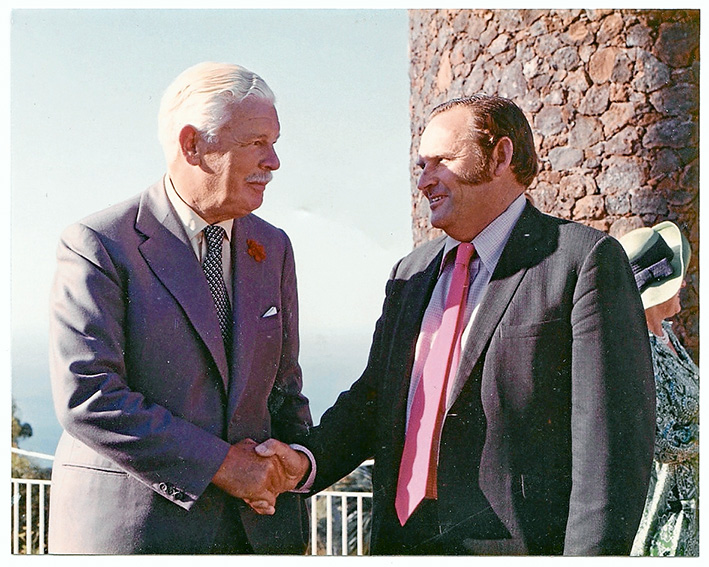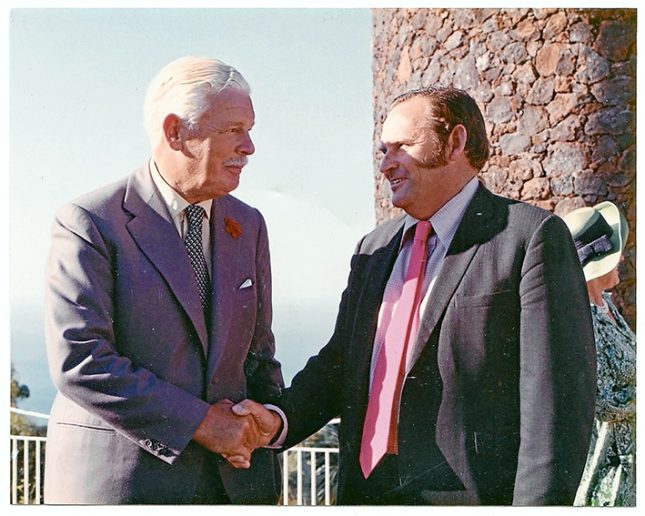OBITUARY
Kenneth Jack Spunner, 24 August 1927–18 June 2016, rabbit trapper, registered hairdresser, wool valuer, dairyman, wool grower, market gardener, shire councillor, real estate agent, land developer

KEN Spunner, the descendant of a 19th century Sorrento lime burner, rose to become head of the Mornington Peninsula’s peak planning body, was a two-time mayor of the Shire of Flinders, and played a significant role in the life of the southern peninsula and Rosebud in particular.
Mr Spunner, who died of pneumonia at 88 last month, was a great-grandson of Irish emigrants, John and Susan Spunner who arrived in the Port Phillip District in 1862.
They settled at Rye, where John Spunner worked as a lime burner. By the early 1840s, lime burning had become the principle industry of the peninsula (ahead of grazing, cropping and fishing) as demand for mortar for brickwork soared in a rapidly growing Melbourne, given further impetus after gold was discovered in Victoria in 1851.
In 1867 the Spunners took up land on the northwest corner of Limestone and Truemans roads. They sold it during a land boom and in 1870 moved to Sorrento where John Spunner burned lime for the Duffy family. He then became a land agent for Sir Charles Gavan Duffy and accepted an offer of land on his Monte Vista estate near the corner of Melbourne Rd and Back Beach Rd (now Ocean Beach Rd), which they named Hillholme.
As Ken Spunner told Nepean Historical Society members during a talk in 1998: “They built a wattle and daub cottage, and it was here that the first Anglican church services were held. The freehold title was registered to Susan Spunner in May 1874. She was a prominent figure in the community and the local midwife.” They had seven children whose later marriages joined them with the founding families of Sorrento such as the Stringers, Croads, Erlandsens, and Eldreds. Susan died in 1899 and John died at Sorrento in 1922 at 87.
Hillholme was inherited by Ken’s grandfather, John William Spunner, who was born at Sorrento in 1867 and died there in 1948 at 81. Ken’s grandmother, Fanny Elenor Eldred, was from a well-to-do English family. The Eldreds ran the Back Beach Coffee Palace, and Mrs Eldred was licensee of Sorrento Hotel. The couple married in 1900 and had six children, including Ken’s father Lance in 1906.
John Spunner was a “cab proprietor” operating horse-drawn vehicles that carried holidaymakers who had arrived aboard paddlesteamers running between Melbourne and Sorrento. He also leased Hillholme to tourists over summer, operated a dairy, and sold eggs and poultry produced on the property.
Ken Spunner was born in 1927 and, as he told the historical society, his childhood was coloured by the 1930s Great Depression. “We ate a lot of rabbits and rabbit broth.” As a boy, he helped his father Lance (universally known as Lal) cut firewood using a cross-cut saw, and move soil for an orchard to part of the Hillholme property where Lal and his mother Doll built a house in the late 1930s. He picked beans for his uncle Frank, who had a vegetable run over summer.
From a young age, Ken was a keen rabbit trapper and by the time he left Sorrento State School and went to Frankston High School, had amassed 100 pounds (equivalent to $8500 today) in his school State Savings Bank account from selling 4000 rabbits at sixpence each.
Between leaving high school and starting work in Melbourne, he trapped foxes for a living. “Fox skins sold well in those days as they were used by the RAAF to line flyers’ helmets. You would get up to 20 shillings [worth $85 today] for a skin, with an outstanding specimen like a beautiful big gold fox I once caught fetching 35 shillings.”
During the World War II he worked in his father’s Sorrento barber shop, becoming a qualified hairdresser. Soldiers from Point Nepean would arrive en masse for a regulation short back and sides, and Ken, aged 15 or 16, would “cut hair on the clock like shearers do, one every three minutes”.
After Frankston High, the only secondary school in the region, he was a wool valuer at Commonwealth Wool in North Melbourne and lived in Collins St.
He met the love of his life, Gloria Parkinson, a legal secretary from Sydney who was visiting her parents, at a New Year’s Eve dance in Sorrento in 1948 and they married a year later in St John’s Anglican Church, Sorrento. They moved from Caulfield a year later when Ken took over Hillholme Dairy from his uncle, Norman Spunner, who had moved it from Sorrento to Boneo Rd. “Norman said we could pay for the cows out of the milk, which we did. We certainly had no money. This is how I started farming in Boneo,” Ken told the historical society.
Ken and Gloria milked 50 cows twice a day at Nepean Park, part of which is now Rosebud industrial estate and the second 18-hole golf course of Rosebud Country Club. On Saturday nights they rode to the Rosebud picture theatre on their bicycles, lighting the way with hurricane lamps hung on their handlebars.
As well as producing milk, they grazed cattle; grew fine grade wool; grew peas, cabbages, cauliflowers, tomatoes and potatoes; and raised three daughters, Suzanne, Kay and Gill.
In 1968 Ken was elected to Shire of Flinders council, and represented Bowen Riding (Whitecliffs to Boneo Rd) for eight years including two as shire president (mayor). For six of those years he was one of two Flinders councillors on the Western Port Regional Planning Authority, and was elected chairman in 1975 during a tumultuous time as state and local governments and conservationists argued over a proposed conservation plan for the shire.
By this time Ken had become an estate agent. With his daughter Kay, they studied to become estate agents and founded K Spunner & Associates, a business they operated for 40 years. Kay now runs Kay Bishop Real Estate, Rosebud.
In his 1998 talk, Ken said “I resigned rather reluctantly from council due to pressure from some sections of the Western Port community, which believed that I had a conflict of interest in that I had moved many amendments to the conservation plan … and had chaired the appeals to that plan. This was prior to the due date of promulgation of the conservation plan. I need not have bothered as the Premier [Dick Hamer] postponed the date and the plan was exhibited for a further 12 months after which only minor amendments were made before it was adopted”.
In 1998, Ken said some of his achievements on the council included opposing a plan to dam Main Creek for a water sports and fishing lake, instead instigating the sealing of the Cape Schanck–Flinders road on its present winding alignment – the S Bend as it was called – to create one of the best scenic drives on the peninsula.
As shire president, he won state government funds for construction of Red Hill Recreation Reserve’s basketball courts and clubrooms, led the move to rezone land in Boneo Rd for Rosebud’s light industrial area, led rezoning of land for Rosebud Country Club’s second 18 golf course, convinced the council to support the Rye reclamation area and boat launching ramp project, supported rate relief for golf clubs, supported lifesaving clubs, and backed shire engineer Peter Parkinson’s push for Sorrento’s main street development.
He persuaded the council to offload Back Beach Reserve (now part of Mornington Peninsula National Park) to the state Department of Conservation Forests and Lands. Along with Bill Green, he was a key figure in the preservation of Greens Bush, now part of the national park.
Mr Spunner was a vigorous opponent of council amalgamations in 1994. He publicly declared: “The amalgamation … with our neighbours Hastings and Mornington has been an unmitigated disaster. Local knowledge is no longer appropriate for councillors or staff, nor is there any desire to use it.”
After leaving the council, he unsuccessfully stood as the National Party candidate in the state seat of Dromana (now Nepean) at the 1979 elections against sitting Liberal MP Roberts Dunstan, and Labor’s David Hassett.
He was an honorary Justice of the Peace for nearly 40 years. In retirement, Ken Spunner enjoyed more time for reading – including the Financial Review every day – travel and spending time with his grandchildren. At his funeral in St John’s Church on 23 June, eldest daughter Suzanne Spunner said he was at his “happiest and most relaxed when children were around”. “He was a phenomenal grandfather. He set up informal scholarships for each grandchild because he believed so much in the value of higher education, an opportunity denied to him.”
In April 2014, Ken and Gloria moved to Ti Tree Lodge, Rosebud West and soon after celebrated their 65th wedding anniversary. Gloria died in April 2015.
Ken Spunner was a link between the early days of European settlement on the peninsula and the modern era. He grew up when people still foraged for tucker and later produced food as one of the region’s best farmers. He went from riding in horse-drawn carts to being known as “the Stirling Moss of Boneo Rd” as he drove at speed between his farms at Cape Schanck and Boneo several times each day. He trapped rabbits and foxes as a boy, and state politicians and bureaucrats as a man.
He is survived by his sister Gloria Susie Wishart, daughters Suzanne, Kay and Gill and their partners, five grandchildren and two great-grandchildren.
First published in the Southern Peninsula News – 12 July 2016


